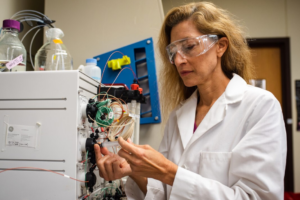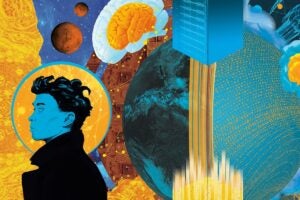AUSTIN, Texas — Researchers have discovered a species of extinct pig-nose turtle that lived alongside dinosaurs and fills a gap in understanding the evolution of turtles.
“Anatomically, it’s one of the most bizarre turtles that ever lived,” said Joshua Lively, who describes the species today in the Journal of Vertebrate Paleontology. “More importantly, it adds to a growing story about ecosystem dynamics during the Late Cretaceous across western North America.”
Lively studied the fossil as part of his master’s thesis at the University of Utah and is now a doctoral student at The University of Texas at Austin Jackson School of Geosciences. The extinct turtle was discovered in Utah’s Grand Staircase-Escalante National Monument by a team from the Natural History Museum of Utah.
The animal, a member of a group of turtles known as baenids, reached about 2 feet in length from head to tail. Its streamlined shell was adapted for living in a riverine environment. When it was alive, 76 million years ago during the Cretaceous Period, southern Utah looked more like present-day Louisiana. The climate was wet and hot, and the landscape was dominated by rivers, bayous and lowland flood plains.
Unlike any turtle ever found, the broad snout of the newly discovered species has two bony nasal openings. All other turtles have just one external nasal opening in their skulls; the division between their nostrils is only fleshy.
Video caption: 3-D reconstruction of the skull of Arvinachelys goldeni based on micro-CT scans and digital segmentation of individual bones.
The pig-nosed turtle’s scientific name, Arvinachelys goldeni, derives from arvina, a Latin word for pig fat or bacon, and chelys, Latin for tortoise. Goldeni pays tribute to Jerry Golden, a volunteer at the Natural History Museum of Utah who prepared the new holotype specimen.
“Volunteers are involved in every aspect of what we do, from field work and digging up specimens to preparing them,” says Randall Irmis, curator of paleontology at the Natural History Museum of Utah and associate professor at the University of Utah. “We couldn’t do what we do without them. We really consider them key team members.”
The new specimen is one of the most complete skeletons of a turtle from the Age of Dinosaurs. It includes not only the skull and the shell, but also a nearly complete forelimb, partial hindlimbs and vertebrae from the neck and tail. Specimens that are this complete allow researchers to better understand the roles the animals played in their ecosystems, Lively said. Most ancient turtle species are represented by fossil remains that often consist of nothing more than an isolated skull or shell.
During the time of Arvinachelys, the Late Cretaceous Period, western North America was a large island continent named Laramidia. A sea stretching from the Arctic to the Gulf of Mexico separated Laramidia from eastern North America.
Dinosaurs of southern Laramidia (southern Utah, New Mexico and Texas) seem to have diversified in isolation from their relatives in the northern part of the continent (Montana and Alberta). The apparent confinement of Arvinachelys and other species of turtles to southern Laramidia fits that same pattern.
It remains a mystery what kept northern and southern populations isolated from each other. The Earth’s climate was in a hothouse phase, with high temperatures not varying as greatly from equator to the poles as they do today.

A combination of rising sea levels and persistent changes in the climate may have created barriers to dispersal during the Cretaceous. Lively said that understanding how ancient animals coped with a changing climate will help scientists understand how modern animals and ecosystems are likely to respond to present-day and future climate change.
The study was funded by the U.S. Bureau of Land Management, the Geological Society of America, Grand Staircase-Escalante Partners, the Paleontological Society Kenneth & Annie Caster Award, and the University of California Museum of Paleontology Welles Research Fund.



